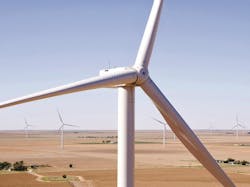GE Vernova Supplying 36 Turbines to O2 Power for 97 MW Wind Power Project in India
GE Vernova has secured an order from O2 Power Private Limited to supply, install, and commission 36 units of its workhorse 2.7-132 onshore wind turbines for O2 Power's 97 MW wind power project in Maharashtra, India.
The agreement will not only help supply renewable energy to various industries and commercial establishments in India but also contribute towards the country’s target of 500 GW of renewable energy capacity by 2030.
The wind farm is expected to be commissioned in a phased manner with completion set for early 2025.
The O2 Power project’s product design will be conducted at GE’s Technology Center in Bengaluru, blade manufacturing in GE’s plants in Vadodara, and assembly at the GE multi-modal manufacturing facility in Pune.
“This investment testifies to our strong commitment to use best-in-class products for our plants and be an equal and formidable partner in achieving India's energy security mission,” said Rakesh Garg, Head of Wind and Co-Founder of O2 Power.
GE Vernova plans to add 1.2 GW in new installs during 2024 to reach a cumulative install base of 5 GW.
About the Author
EnergyTech Staff
Rod Walton is head of content for EnergyTech.com. He has spent 17 years covering the energy industry as a newspaper and trade journalist.
Walton formerly was energy writer and business editor at the Tulsa World. Later, he spent six years covering the electricity power sector for Pennwell and Clarion Events. He joined Endeavor and EnergyTech in November 2021.
He can be reached at [email protected].
EnergyTech is focused on the mission critical and large-scale energy users and their sustainability and resiliency goals. These include the commercial and industrial sectors, as well as the military, universities, data centers and microgrids.
Many large-scale energy users such as Fortune 500 companies, and mission-critical users such as military bases, universities, healthcare facilities, public safety and data centers, shifting their energy priorities to reach net-zero carbon goals within the coming decades. These include plans for renewable energy power purchase agreements, but also on-site resiliency projects such as microgrids, combined heat and power, rooftop solar, energy storage, digitalization and building efficiency upgrades.
